Mahakal Temple
Mahakal temple, locally called as ‘Daara’ is located
on the zenith of the observatory hill above the famous Mall Road of Darjeeling.
It is a sacred Hindu Shrine where devotees from far off places come to
visit and pay homage to Mahakal Lord Shiva.
It is located 20 minutes away from the main road of
Mall Road in Darjeeling.The steepy curvy road towards the temple is worth
walking.
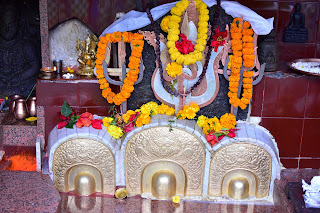 |
| Mahakal Mandir,Darjeeling |
The place is well-regarded by Hindus and Buddhists. It presents the rare combination of a spiritual place dwelled by two distinct religions. There is a historical significance behind it. In the year 1765, a monk named Dorje Rinzing had built a monastery on this hilltop, naming it as the Dorjeling Monastery. Darjeeling is said to have derived its name from this monastery’s name – Dorjeling where ‘Dorje’ means thunderbolt and ‘Ling’ means land, hence, the land of thunderbolts. It is also believed that in the year 1782, three Shiva Lingas self-manifested themselves on the same spot where the monastery was built. During the invasion of the Nepalese Gorkhas from Nepal in 1815, the monastery was vandalized and demolished. They left the three Lingas in its original form. Though the monastery was relocateda few kilometers below the Mall Road in 1861 it was named as Bhutia Busty Monastery.
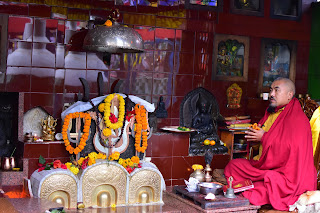 |
| Buddhist monk at Mahakal mandir |
This became the worship centre for both Hindus and Buddhists. This is the only place in India where we can find the Buddhists monks and Hindu priests sitting across each other and worshipping together and following their religious sanctityin an amicable manner. The yellow, red and orange teeka with colorful thread on the wrists cherished with the sweet Prasad fills the entire atmosphere with spiritual well-being. On the other hand the fluttering vibrant prayer flags and beaming lights illuminates the area with hope and bliss of a prayerful mind.
The hill is encircled by pine trees, the temple grounds are filled with colorfulBuddhists wheels and hundreds of brass bells hung all around the railings. The three black rocks are worshipped as Shiva Linga; sit in the altarof this round temple. A white plastic figure of Nandi, the sacred bull of Lord Shiva, sits at the entrance.
There are precincts dedicated to ShirdiSai Baba, Lord Hanuman, Goddess Kali, Durga, Lord Ganesha, Radha and Krishna, Lord Ram and many more powerful idols. A Chorten (Tibetan Memorial Shrine) is located just beside the temple upholding the relics of Dorje Rinzing Lama.
Associated with this are few dark caves and tiny
rock-like structures if we explore the hill. The view of the Kanchenjunga range
from this particular place is mesmerizing. Monkeys are all over, hence, one
should take care of their gestures and packets held in the hands. Beautiful
birds are the permanent residents of this place who keep adding charm to its
existence.
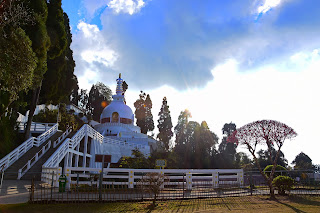
Japanese Temple
Japanese Temple and Peace Pagoda

This is an eminent temple located at a distance of 10
minutes’ drive from the main market of Darjeeling.It showcases the classic
Japanese style of architecture. It is also known as Nipponzan Myohoji Buddhist
Temple which is two storeyed building constructed in Japanese style in the year
1972. It belongs to the Japanese Buddhist Sangha of Nipponzan Myohoji sect of
Buddhism. The fervent followers of this sect chant ‘Nam-Mhoyo-Renge-Kyo’ and
reflect the essence of Buddhism forbeing enlightened. There is a photo gallery
that provides us the information of Peace Pagodas situated in all over the
world. Following the wooden stairs, there is the prayer room on the first
floor. This prayer room of the temple is filled with tranquility and wisdom.
Hand held drums are beautifully placed in the prayer hall and during the prayer
time the visitors can be a part of the aesthetic moment. The rumbling sound of
these drums fills the atmosphere with divine wavelengths. Moments spent in this
prayer hall gets imbibed with the soul and partner with whom you visit.
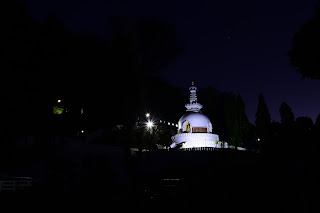 |
| Japanese Temple at Night |
The Peace Pagoda is constructed within the temple premises. It is the tallest independent structure in Darjeeling. Its height is 28.5 meters (94 ft.) and diameter is 23 meters (75 ft.). As we climb the stairs we find the concrete models of lions. The huge peace pagoda showcases the four incarnations (avatars) of Lord Buddha polished in golden color.The walls of this pagoda depict the different stages of Gautama Buddha’s life. Its foundation stone was laid in the year1972 by Nichidatsu Fujii.It was designed by Dr. M. Okha of Japan which tool three years to get completed. We get a panoramic view of the serene landscape including the Kanchenjunga range making it a prominent tourist spot. The long white railing till the peace pagoda gives it a picture perfect architecture. This peace pagoda is a symbol of promoting world peace and harmony.
Visiting Hours – 4 AM to 7 PM
Prayer Timings – 4:30 AM – 6 AM, 4:30 PM – 6 PM
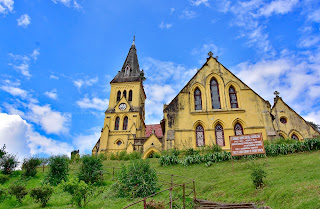
St. Andrews Church
St. Andrew’s Church

One of the best historic buildings of Darjeeling is
St. Andrew’s Church. This historical church belongs to the colonial era and is
located 1.5 kms away from the Darjeeling Railway Station. We can take a walk
towards the Mall Road and can easily find it nearby Bhanu Bhavan and on the
Mall Road. The first glance on this church makes us fall for it as the classic
architecture gains out attention. This Anglican Church is named after St.
Andrew, a patron saint of Scotland. The foundation stone of this church was
laid down on St. Andrew’s Day on 30th November, 1843 and was
completed in 1844. It was rebuilt after it was pretty damaged by the massive
earthquake of 1873. The capacity of the church is to accommodate around 200
persons. A clock tower was added in the year 1883 that used to chime every hour
and could be heard all over the town of Darjeeling.
 |
| St. Andrews Church |
Tourists can admire the excellent British architecture by witnessing this construction. The interior walls of the church are inlaid mural tablets and brass plaques dedicated to the memory of the few old residents, chief amongst them is Lt. Gen. Lloyd, the discoverer of Darjeeling, Charlotte Countess Canning (wife of the Governor General of First War of Independence) etc. Based on the Gothic architecture, this church has the featured like pointed arch, ribbed vault and flying buttress. The ethereal and discreet ambience of the church engages the heart with wonder and bliss.
The
holy communion is held on first and third Sunday of every month. The mass timings
are 9 AM between March and November and 9:30 AM from December to February. The
church welcomes all in order to give them the taste of bygone British era. It
organised special carol service during Christmas in which many people
participate and feel the joy of togetherness.
Sonada Monastery – SandrupDarjayCheoling Monastery
This is a beautiful monastery located in Sonada, a place between Darjeeling town (17 kms) and Kurseong (16 kms) on the way to Darjeeling. It is widely popular as the quaint stop on the Darjeeling Railway Station. The line of beautiful chortens adds beauty of this monastery.
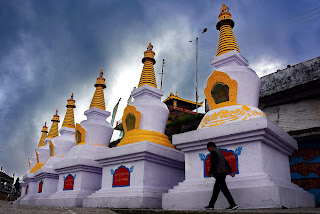 |
| Sonada Monastery |
This monastery was founded in 1966 by his holiness Dorje Chang Kabje Kalu Rinpoche also known as Kalu Rinpoche who was born in Tibet. He had established a three-year retreat centre at Sonada and this particular monastery was his primary residence as well as the international seat of Shangpa Kagyu tradition. He passed away at Sonada in 1989 and his mummified body has been enthroned inside the monastery itself. There are a number of huge stupas along with the statue of the Rinpoche. The main shrine includes another statue that is a mummified body of Vajradhara Lama. We can always tread along the premises even if the shrine remains closed. The monastery has a rare and extremely valuable thangka (Buddhist painting on a scroll) bearing the portrait of Jey Rinpoche. The picture itself and the writings are made of pure gold.
The prayer hall is a wide area in the center that becomes alive with the monks chanting the hymns and Holy Scriptures. This monastery is not just a worship place but also a monastic school for the young Buddhist monks.
ChhotiMasjida and Badi Masjid
Chhoti Masjid is located in the Chauk Bazaar of Darjeeling. It came into being when the a traveler’s home named as MusafirKhana for the Muslim traders was built in 1775 with a bamboo-styled Masjid
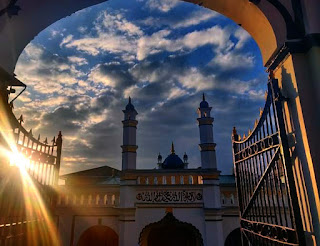 |
| Anjuman Islamia |
in Darjeeling for religious purposes and some of them later became the permanent residence. The Masjid Management team operated in an organised manner and rented stores to support MusafirKhana (Guest House) which used to be free for all individuals regardless of their caste and creed.
The Jama Masjid (bari masjid) mosque and its adjacent complexAnjuman-E
Islamia was built by Khan Bahadur Dr. Abdul Aziz of Jalandar in 1850 and
rebuilt in 1910. It is an edifice landmark of Darjeeling.
It is very pleasant to witness the special occasions
celebrated with great pomp and show in these mosques.
Gurudwara
Gurudwara Guru Nanak Darbar is located at Dr.
ZakirHussain Road, Chauk Bazar. It is a little uphill walk but worthy for its
beauty and serenity. The view from this place is amazing.
Dali Monastery
Dali monastery is one of the enchanting monasteries of Darjeeling. It is located 2.5 kms away from the Darjeeling Railway Station. Its name is DrukSangagCholing Monastery which is the biggest monasteries of the state.
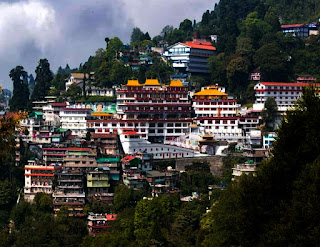 |
| Dali Monastery |
It was built by KyabjeyThuskey Rinpoche in 1971. The monastery (gumpa) was inaugurated by His Holiness Dalai Lama in 1993 followed by three days of teachings. Around 210 Tibetan Buddhists of the Drukchen sect reside in this monastery.
This monastery is the house of vivid collection of
religious books on Buddhism and Philosohy. The striking feature of this
monastery is the central cylindrical hall of about 6 ft high golden Tibetan
prayer wheels which the monks keep turning while offering their hymns and
prayers. If we are lucky enough to reach here early morning around 5:30 AM to 6
AM or during evening at 5:30 PM to 6 PM then we can witness the monks deeply
involved in offering prayers to Lord Buddha.
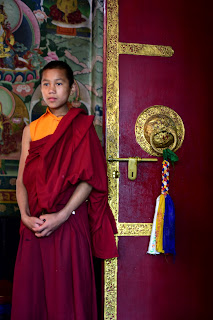 |
| Monk at the monastery |
Darjeeling tourism is incomplete without visiting this grand pious structure. The temptation begins from the moment we get its glimpse on the road before reaching the hotel. The colorful walls depicting the life and teachings of Lord Buddha along with the railings of mini prayer wheels and flamboyantprayer flags waveringall over is absolutelyappealing.
Another charming attraction is the little monks draped
in red and yellow robes roaming and playing cheerfully all around the premises.
Having a well settled Tibetan educational institution there is a good number of
young scholars in their unique school uniforms inside the monastery. One can
often see them petting the random animals who visit them. The lessons of
compassion and kindness can be easily witnessed here.
The Kunga Palizor Café shop within the monastery
premises gratifies the needs of the tourists, residents and students of the
monastery itself. It offers pure vegetarian food items. One can also buy one of
the various books based upon Buddhist texts, scriptures, culture and Lord
Buddha’s teachings.
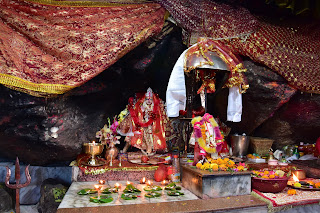
Senchel Devi Dham
Senchel Devi Dham (Tiger Hill)

Tiger Hill is the most famous touring point of
Darjeeling. It is located at an altitude of 2590 meters and at a distance of 13
kilometers away from the central Darjeeling. On the way to reach tiger hill
there is this famous Dham. There is a lake beside this named as Senchel Lake.
This lake is the main source of water for entire Darjeeling.
The Senchel Devi Dham is dedicated to Maa Durga.
Pilgrims come to visit here from far off places. Most of them visit this temple
with whole family on special occasions and offers their prayers to the deities
of this temple. Since it is located in the middle of the forests it has natural
set up and the atmosphere is filled with peacefulness. This divine
manifestation of the area was actually dsicovred by a ‘jhyakri’ much before the
British era.
The entrance has bells clinging from top and then it descends down towards the main shrine. There are two paths dissected with a railing. The railings are very interesting as it is full of red bangles, little bells and chunnis. All these are offerings to Maa Durga. The neat path is covered with mat. After treading on the clear path we enter into the main shrine which is a large protruding rock which is the ‘scared stone’ that’s worshipped since centuries. Followed by the declaration of the ‘jhyakri’ who discovered this place, this sacred stone is worshipped as the symbol of Maa Durga. Earlier it was very steepy path but for the convenience of the devotees, the temple was built and the path made way for all age groups. Its orginal name is SinghakoAanchal – Singhancal, later called as Sinchal.
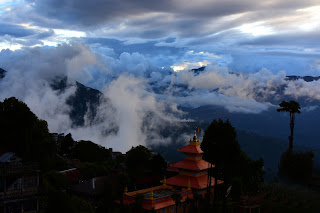
Dhirdham temple
Dhirdham Temple

This is a
famous Hindu shrine of Darjeeling that is located around 100 kms from the most
popular Darjeeling Railway Station. One of the oldest structures this temple is
dedicated to Lord Shiva. It was built in the year 1939under the reign of the
then king of Nepal, Purna Bahadur Pradhan and has been inspired by Tibetan and
Buddhist architectural styles. It has been designed by a Gorkha architect, Beg
Raj Sakya, based on the architectural style of Pashupatinath temple of
Kathmandu, Nepal.
Dhirdham temple
The temple is
a multilayered pagoda painted in red, yellow and white. There is a white
colored statue of Lord Shiva near the entrance. This idol symbolizes
PanchaBakramTrinetram depicting five varied facial expressions of Lord Shiva
with his supreme third eye. Additionally, three Shiva-Lingas representing
Brahma, Vishnu and Maheshwar are believed to be manifested here.
The best time
to visit this temple is during Shiv Ratri in the month of February and March. A
huge rush of devotees can be witnessed during this auspicious festive. The
temple remains open from 8 AM in the morning to 6 PM in the evening.
Gems that adorn the beauty of Darjeeling
The elevated abode of Gods fills the air with purity
and peace. These places are not just a place of worship but also live portions
of history. They all depict their own history and the reason for their
existence till date and beyond. They are the iconic landmarks of Darjeeling
that gains a lot of tourist attraction.



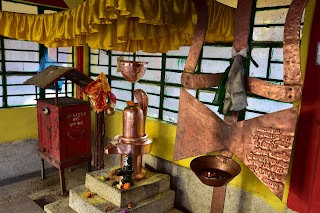
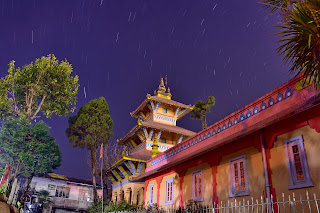







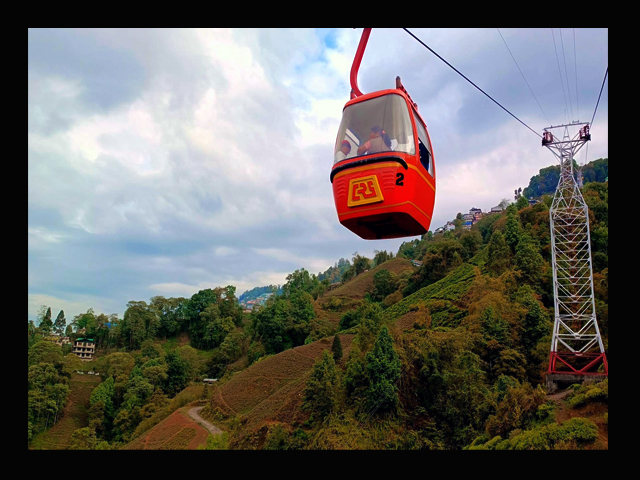


0 Comments